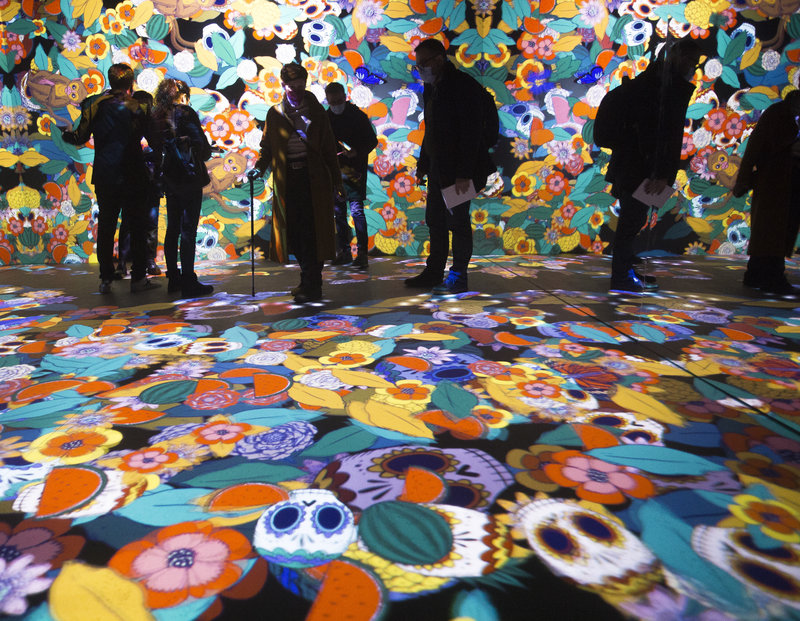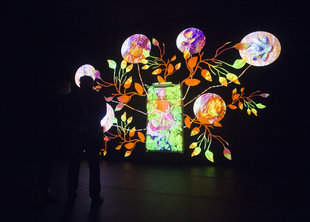Frida Kahlo’s pain
The Digital Arts Centre of Barcelona invites us to immerse ourselves in the turbulent life of Frida Kahlo, one of the 20th century’s most innovative and influential artists
Frida Kahlo had a difficult and turbulent life. On the last page of her diary, which became her main confidant in her final years, she wrote: “I look forward to leaving (and I hope never to return).” Reading the diary, which for many years remained anonymous and the artist did not want to be published, is to immerse oneself in the depths of her pain. It is a mirror of a broken soul, exhausted by suffering.
Her first test came early. When she was just 19, she had a road accident that would mark her whole life. A tram crashed into the truck she was travelling in, breaking her spine, neck, ribs and pelvis. From that fateful day in 1925 until her death in 1954, Kahlo underwent 32 operations and the bed became her inseparable companion. In a well-known photograph by Bernice Kolko, she is seen stretched out, done up from head to toe in one of the typical costumes that characterised her, and with her hands clasped, as if trying to cover up her tortured body. However, the most striking element is the penetrating, almost hypnotic gaze, crowned by those famous thick eyebrows.
The bed was also the place where she started painting. To make it easier for her, her mother ordered an adapted easel and placed a mirror above the bed to help her to see. If the bed became her first creative space, her body was her first source of inspiration. She used to say that she portrayed herself “because I spend a lot of time alone and because I’m the subject I know best.” As with Rembrandt and Van Gogh, her self-portraits are a visual biography in which we discover passion, innocence, suffering, and also the catharsis of knowledge. Through her paintings and her diary, Frida described pain like no other; a pain that was very much her own, but that in a few extremely turbulent years, with two world wars and several genocides, became the pain of the whole world. The diary does not only reflect Kahlo’s pain, however, but also her joy, her sense of humour and her overflowing imagination.
Relationship with Rivera
Kahlo’s pain also included heartache. On one occasion she admitted that she’d had two accidents during her life: that of the tram and that of Diego Rivera. The relationship with the Mexican artist was as productive from an artistic point of view as it was destructive from a personal one, with continuous break-ups and reconciliations, and infidelities on both sides, all of which left a painful imprint. Frida also had a number of miscarriages. When she was recovering from one of these in Detroit, she painted a disturbing self-portrait of her having the miscarriage. In the words of Rivera, her erstwhile partner, it was a painting that “exalted the feminine quality of truth, reality, cruelty and sorrow. Never before has a woman painted such a tormented poem on a canvas as Frida did in Detroit at the time.”
Ideal’s take
To get across the complexity of Frida Kahlo through an audiovisual exhibition, without any of her 150 works on display, does not seem like an easy task. Especially considering that over the years she has become a cult artist, with many followers who often have their own view of her. The books, the exhibitions, and the web pages dedicated to Frida show how much interest and passion the Mexican artist awakens. Yet the Ideal Digital Arts Centre of Barcelona, which recently invited us to immerse ourselves in the world of Gustav Klimt, was ready to take on the challenge. The centre’s director, Jordi Sellas, sums it up well: “We have focused on her to create an immersive biography, to go one step further in the new immersive languages.” Through a wealth of resources that are as original as they are surprising, the visitor is fully immersed in the world of Frida Kahlo: her iconography, her themes, her personality, the political contradictions and the events that made her an exceptional artist and a myth of the 20th century lead us on an enthralling journey.
Upon entering, the visitor is faced with a Mexican altar, a very typical element of Latin American religiosity. Yet in this case the Virgin is replaced by Frida Kahlo, as if she had become Tlazolteotl, the Aztec goddess of both impurity and purity. Next comes a long corridor with illuminated panels that introduce us to the main stages of the Mexican artist’s life, preparing us with a good dose of knowledge about her life before entering the exhibition’s other rooms. The artist liked to say that she was born on the winds of the Mexican revolution, and she would even lie about her date of birth to fit the chronology. We are told that “she was not born with the revolution,” but that “a revolution arrived along with her.”
One of the most impressive installations in the exhibition is ’L’instant’, from the Nueveojos studio. Through a hologram, we see a porcelain Khalo pierced by an iron bar and shattered into thousands of unrecognisable pieces. The technology has been christened Multilayer by its creators, who achieve the effect by using five overlapping transparent screens that give the effect of volume. The result is spectacular but it also reveals how the fragility of Frida Kahlo, during that fateful road accident on September 17, 1925, becomes a symbol of human fragility, subject to uncontrollable chance that is capable of changing the future in an instant. Next to that, ArtBreeder uses an artificial intelligence logarithm to map an image of the young convalescent artist onto a vertical bed, with some of the most characteristic elements of her painting. The bed is not only a space of suffering, of martyrdom, but also of creation and overcoming adversity.
The next two rooms feature the characteristic symbols of Kahlo’s work. Skulls, Mexican traditions, fruit and animals, and of course hospital beds, come together in a sensory and interactive installation created by Play a Bit. One room is dedicated to self-portrait, one of the artist’s favourite forms, and visitors have the opportunity to paint their own portrait. Meanwhile, AI tech designed by the Broomx company, which has a long history with immersive experiences, shows visitors how Frida’s work was done on the walls of La Rosita tavern, where she took her students to practise decorating the premises.
At the heart of the exhibition is the large, central immersion room, which reviews episodes of Kahlo’s life. The visitor will find a wealth of material selected by the Martes studio from 30 archives. The soundtrack is by Raffel Plana. This 30-minute audiovisual montage evokes key moments and aspects of Frida Kahlo’s life: frustrated motherhood, the ideological contradiction of her devotion to communism alongside her flirting with the American bourgeoisie, and her travels, such as her trip to Paris in 1939. Apart from almost becoming another victim of fascism, it was in the French capital that Frida made contact with the surrealists. One of these was Salvador Dalí, who will be Ideal’s next subject. An exhibition in collaboration with the Gala-Dalí Foundation will open in Barcelona in September and will go on to be shown in many other cities around the world.
The sixth room helps us understand how the Mexican artist has become a pop and fashion icon. There are traditional Mexican costumes that have been recreated by Cooperativa del Tejido Tradicional Renacer 8.2, as well as the famous Barbie doll of the artist, a symbol of consumerism that reflects the extent to which Frida has transcended borders and become a global symbol.
Near the end of the tour we come across a delightful surprise, ’Cadavre exquis’. In this 360-degree virtual reality experience the visitor disconnects from the real world and is installed in Frida Kahlo’s bed for nine minutes. The journey begins in her room, surrounded by paintings and books, but then takes to the air, leaves the garden of Casa Azul and begins a flight through Kahlo’s inimitable universe while we listen to the well-known song of La Llorona, which was made popular by the iconic Mexican singer, Chavela Vargas. The experience is extremely intense, with an avalanche of emotions and sensations that take us into the world of the artist and her pain, that inescapable companion of the human condition. Finally, the visitor can enjoy exploring the photo booth, which uses artificial intelligence created by Sergio Albiac.
The Frida Kahlo exhibition, which will run until April, is an absolute must-see, both for Kahlo devotees and for those open to learning more about this most unique of artists. It will be followed by one of the most ambitious projects that Ideal has taken on: an exhibition on Dalí, in collaboration with the Gala-Salvador Dalí Foundation. “The Frida Kahlo production will go on to tour Belgium, the United Kingdom, Mexico, Chile and Colombia for three years, and we hope that in the case of Dalí it will go all over the world,” says Ideal director, Jordi Sellas, before adding: “It is an experience that will change the concept of immersion and the structure of Ideal.”
feature art
feature art
A cult artist
Frida Kahlo (Mexico City, 1907-1954) is in fashion these days. In November, one of her works, Diego and I (1949), sold for just over 30 million euros, a figure four times higher than the previous amount paid for an artwork by a Latin American artist. Curiously, that was none other than her husband, Diego Rivera. Beyond the numbers, Frida Kahlo’s troubled life continues to enthral thousands of people around the world, while her influence on art and literature is clear.












